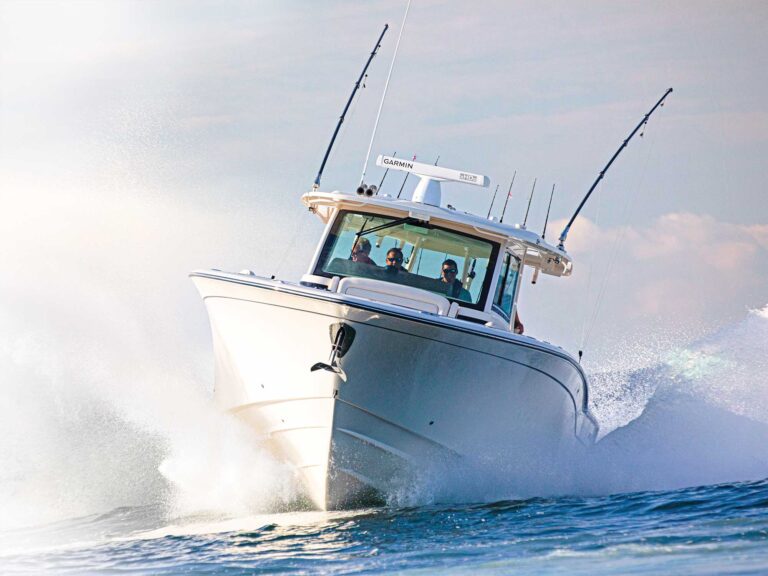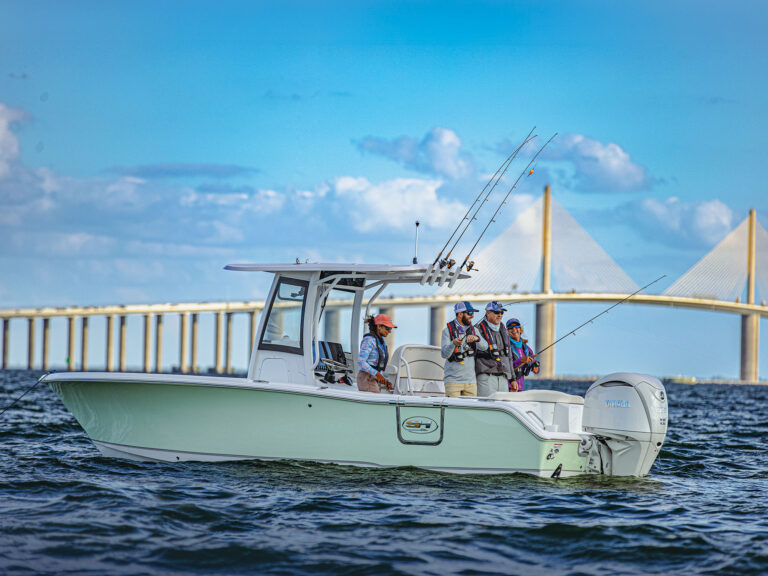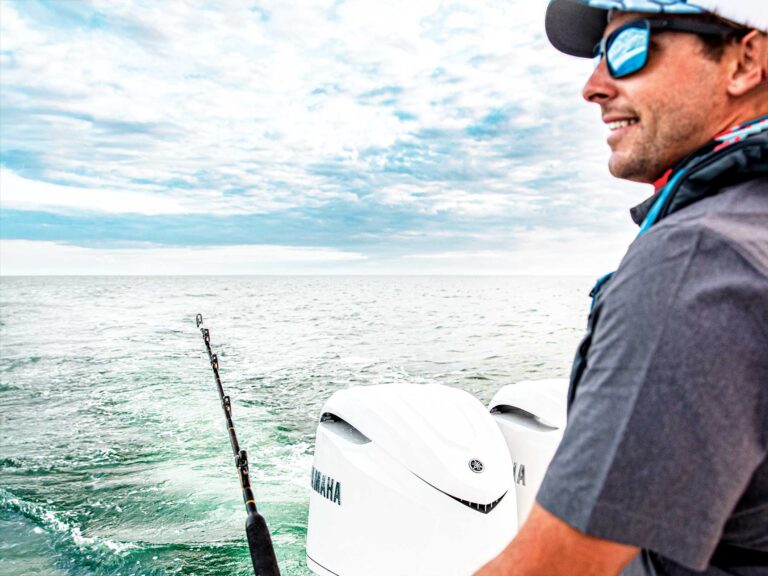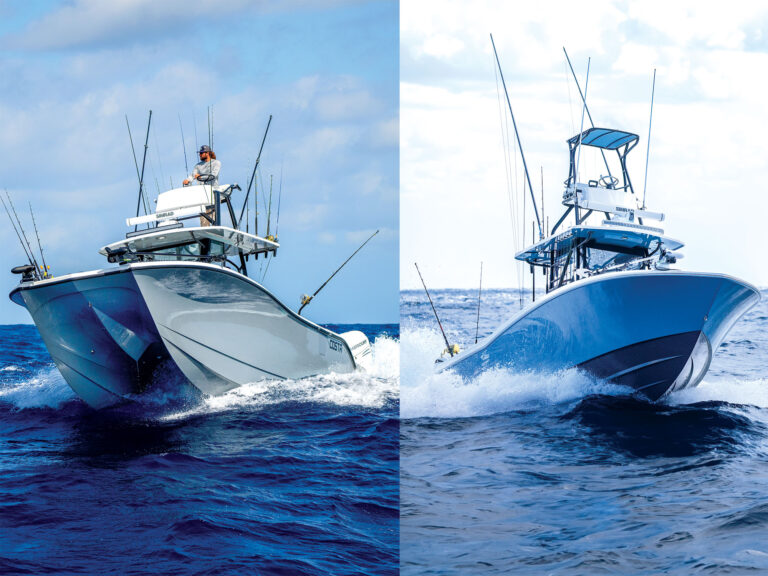And most of the time, we won’t. But if the unthinkable actually happens, as we all know it can, would you know what to do to save your boat, your crew and yourself?
In the hopes of fostering a higher level of safety knowledge, the United States Power Squadron (USPS) recently produced a television show for the Speedvision network that asks 23 critical questions regarding boating safety. The USPS has been educating boaters since 1914, and this latest outreach effort covers a lot of ground (or water, as the case may be).
Valuable Video
On the show, host Ted Rankine poses questions to real folks on marina docks around the country. Now, we can’t be sure if the producers prompted the questionees to give wrong answers for dramatic effect, but a lot of them missed even the easiest questions. Whether staged or not, ignorance of boating safety is rampant, a fact that becomes all too apparent when you fish in crowded waters on any given weekend.
The questions on the show, now available on video, are pretty general, but they address critical boating-safety issues, including rules of the road, required safety equipment, required lighting of recreational vessels and more. Suffice it to say that all of us could probably use a refresher course in boating safety from time to time, no matter how well prepared we like to think we are.
That’s because you never know when something bad will happen at sea, and there may not be anyone close enough to respond quickly. You must be self-reliant.
A friend of mine found that out the hard way a few years ago. He and his family left Palm Beach, Florida, bound for the Bahamas aboard their 40-foot sportfisherman. It was a slick-calm, beautiful summer morning, and all indications were that they would have an uneventful crossing.
As the morning sun cleared the horizon, my buddy realized that his sunglasses were down below in the salon. The entire family was up on the bridge with him, most of them dozing, so he rousted his son to head below and get the glasses for him. The boy descended the ladder and opened the salon door to find the entire cabin filled with acrid smoke. The boat’s smoke detectors were wailing, but no one could hear them above the engine noise.
Within seconds the automatic halon fire extinguishers went off, but the smoke continued to billow out of the engine room. The family hastily gathered in the cockpit, jumped into the Boston Whaler skiff being towed behind them, and pulled away from the burning hull. The Coast Guard arrived a short time later, but it was too late. The boat burned to the waterline and sank before their eyes in a matter of minutes.
What if they had not been towing a skiff? Fortunately, my friend is a very safety-conscious individual and keeps a safety bag in the cockpit containing a life raft, lifejackets, flares and emergency rations. Even without a skiff they would have been able to deploy the raft and get away from the burning boat. But how many of you store your safety gear down below in some forgotten hole where such an engine fire would have made retrieval impossible? In that case, you would have ended up in the water with no flotation device or flares, a seriously frightening scenario.
Lifejacket Drill
Evacuating a vessel is one safety issue that needs to be addressed by all boaters, but there are many more. In the USPS video, a guy with a stopwatch times a family aboard their boat as they attempt to retrieve their lifejackets and put them on correctly in 30 seconds or less. Needless to say, it’s the proverbial Chinese Fire Drill. Could you do it aboard your boat? The video also demonstrates how difficult it is to put a lifejacket on once you’re in the water, and points out the importance of buying lifejackets that contrast in color with the water, so rescuers can more easily spot you from the air.
With some sober forethought, you can help ensure the safety of your family or crew, and that’s what the USPS video is all about. You can obtain copies of the safety video for presentation to groups such as fishing clubs, yacht clubs or marinas, and the USPS can also send a guest speaker along to help answer questions. Call 888-FOR-USPS (888-367-8777) to obtain copies of the video. In the meantime, we thought we’d ask you a few of the questions here, just for fun, so here goes:
1. ¿The wearable lifejacket that provides the most support and protection is:
A ¿TYPE V (Special Use Device)
B ¿TYPE IV (Throwable Device)
C ¿TYPE I (Offshore Lifejacket)
D ¿TYPE III (Flotation Aid)
The answer is “C.” The Offshore Lifejacket provides the most flotation, handy if you have to spend a lot of time in the water, and is designed to keep the wearer upright, even if he or she is unconscious. Many fishermen buy the much cheaper TYPE II lifejackets, which are technically legal, but provide inferior flotation. Cough up the extra dough and buy the TYPE I jackets if you’re going offshore.
2. ¿At what blood or breath alcohol level is it illegal to operate a vessel?
A ¿.08
B ¿.10
C ¿.50
D ¿1.0
This is sort of a trick question, as there are two possible correct answers. The answer can be “A” or “B,” depending on what state you live in. Marine enforcement officers are taking an increasingly dim view of boating while intoxicated, and the penalties can be severe. Some states even tie a boating DUI to your driver’s license. Personally, I just hope I never run into the guy with the 1.0 blood alcohol level!
3. ¿If your boat capsizes:
A ¿Swim to the nearest shore.
B ¿Yell until help arrives.
C ¿Swim to the boat and stay with the boat.
D ¿Swim away from the boat as quickly as possible.
This one seems simple, but some people don’t get it. The answer is “C,” and brings to mind a sad story. A friend who flew helicopters in the Coast Guard told me about a search-and-rescue mission he once flew many years ago out of Pensacola, Florida. A man had bought a used wooden sportfisherman and wanted to take it to Tampa, an open-water run of around 200 nautical miles. He left one evening when the forecast was predicting lousy weather and most people advised against it. His family, including several small children, were aboard.
After midnight, the Coast Guard received a distress call from the boat indicating that they were taking on water fast. Helicopters were launch-ed, but the first wave couldn’t find them in the pre-dawn darkness and returned to base. My friend was in the second SAR wave and arrived on-scene right at dawn. In a short time they located the boat’s hull, which had not sunk, but had merely capsized. There weren’t any people to be seen, however.
The pilot took the chopper to a higher altitude to look around, and they spotted the family, a couple of miles from the overturned hull. There were an estimated 100 sharks encircling the terrified family. The family was quickly retrieved from the water, but one child was dead from a shark bite and another died of hypothermia. Had they stayed with the hull, they might have been able to climb onto it and avoid this tragedy.
3. ¿The vessel equipment required by law:
A ¿Is only part of that needed for safe and comfortable operation.
B ¿Does not include visual distress signals and fire extinguishers.
C ¿Includes charts and other navi-gational equipment.
D ¿Covers all your needs for safe operation of your vessel.
This one stumps many people. The correct answer is “A.” You should consider the mandatory safety-equipment list to be the bare minimum of what should be aboard every time you go fishing. What are the minimum requirements? You can get them from the Coast Guard in a booklet entitled, “Federal Requirements and Safety Tips for Recreational Boats.”
The next time you get together with whatever type of club you belong to, consider watching a copy of the USPS video. It’s fun to watch and, while it sounds trite, it really could save your life. To find out more about the Power Squadron, check out their website at www.usps.org.









